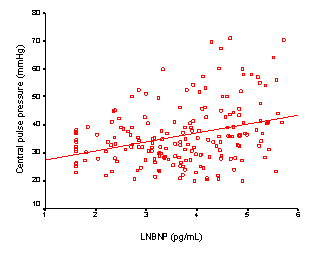| pA2 online © Copyright 2004 The British Pharmacological Society |
151P
University of Newcastle Winter Meeting December 2004 |
Plasma B-type natriuretic peptide is associated with increased central blood pressure and arterial stiffness C. M. Mceniery, Yasmin, S. Wallace, I. B. Wilkinson & J. R. Cockcroft1. Clinical Pharmacology Unit, University of Cambridge, Cambridge and 1Department of Cardiology, Cardiff University, Cardiff, UK. |
|
Plasma B-type natriuretic peptide (BNP) concentrations predict the risk of death and cardiovascular events in subjects with and without heart failure and in hypertensive individuals. B-type natriuretic peptide is secreted from cardiomyocytes in response to atrial or ventricular wall stretch. Since blood pressure, and pulse pressure in particular, varies along the arterial tree, we hypothesized that BNP production would be more closely related to central pulse pressure than to peripheral pulse pressure. In addition, we hypothesized that plasma BNP concentrations would be associated with indices of large artery stiffness. Therefore, the aim of the current study was to determine the relationship between plasma BNP, peripheral blood pressure and central blood pressure and arterial stiffness, using the non-invasive technique of pulse wave analysis (PWA).
Two hundred and thirty-six subjects (mean age 42 ± 18 years; 97 females) were studied. All subjects were free of cardiovascular disease and medication. After 15 min of supine rest, blood pressure and radial artery waveforms were recorded in duplicate, and central blood pressure and augmentation index (AIx), a measure of systemic arterial stiffness, were calculated from derived aortic waveforms using PWA. The aortic pulse wave velocity (PWV) was then measured by sequentially recording ECG-gated carotid and femoral artery waveforms, and blood samples were taken for the assessment of plasma BNP (Roche Diagnostics, N-terminal proBNP).
Univariate correlation analyses showed that central, but not peripheral pulse pressure (PP), was significantly and positively correlated with plasma BNP concentrations (Figure 1 [AH1] [AH2]; central, r = 0.46, P < 0.001 vs peripheral, r = 0.06, P = 0.9). Other parameters which were significantly and positively correlated with plasma BNP concentrations were age (r = 0.52, P < 0.001), gender (r = 0.47, P < 0.001), AIx (r = 0.61, P < 0.001), central PP (r = 0.46, P < 0.001, aortic PWV (r = 0.35, P < 0.001) ejection duration (r = 0.27, P < 0.001) and MAP (r = 0.2, P = 0.02). In a multiple regression model, plasma BNP concentrations were independently associated with female gender, MAP central PP, central AIx and aortic PWV (r2 = 0.42, P < 0.001).

Central pulse pressure and indices of central arterial stiffness are independently associated with plasma BNP concentrations in individuals free of cardiovascular disease and medication. These data provide a possible explanation for the increased risk for death and cardiovascular disease associated with high plasma BNP.